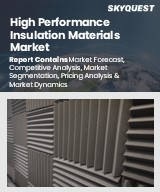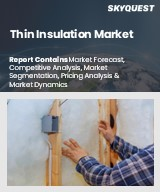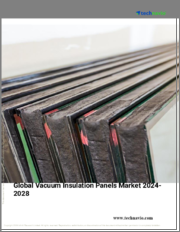
|
시장보고서
상품코드
1766149
진공 단열 패널 시장 예측(-2032년) - 코어 재료별, 배리어 필름 재료별, 패널 형태별, 용도별, 지역별 분석Vacuum Insulation Panels Market Forecasts to 2032 - Global Analysis By Core Material, Barrier Film Material, Panel Shape, Application and By Geography |
||||||
Stratistics MRC에 의하면, 세계의 진공 단열 패널 시장은 2025년에 91억 달러에 달하고, 예측 기간 중에 CAGR 5.7%로 성장하여 2032년에는 135억 달러에 이를 전망입니다.
진공 단열 패널(VIP)은 단단한 코어 소재를 기밀성이 높은 외피로 둘러싸고 공기를 빼내어 진공상태로 만들어지는 고성능 단열재입니다. 이 진공 상태로 인해 열전도가 크게 감소하여 기존 소재에 비해 우수한 단열성을 얻을 수 있으며, VIP는 냉장, 건축, 콜드체인 물류 등 공간 효율과 열 성능이 중요한 용도에 널리 사용되고 있습니다.
미국 에너지부 자료에 따르면, 진공 단열 패널(VIP)을 개보수 벽 패널에 통합하면 에너지 사용 강도를 최대 67.4%까지 줄일 수 있으며, 기존 단열재에 비해 66% 더 얇은 패널(4인치 대 12인치)로 동일한 R값(R-44에서 R-47)을 달성할 수 있다고 합니다.
건축 및 HVAC 수요 급증
진공 단열 패널 시장은 건설 부문의 급격한 성장과 HVAC 시스템에 대한 수요 증가에 힘입어 크게 성장하고 있습니다. 도시화가 가속화되고 에너지 효율이 최우선 과제로 떠오르면서 건설업체와 개발업체들은 우수한 단열 성능을 갖춘 진공 단열 패널을 점점 더 많이 채택하고 있습니다. 또한, 전 세계적으로 강화된 건축법 및 규제는 더 높은 에너지 효율 기준을 요구하고 있으며, 이는 주거 및 상업용 프로젝트 모두에서 이러한 고급 단열 솔루션의 채택을 촉진하여 시장의 견고한 성장을 가속하고 있습니다.
불안정한 원자재 가격
이러한 패널의 생산은 금속, 플라스틱, 실리카 및 유리 섬유와 같은 핵심 물질과 같은 재료에 의존하고 있으며, 그 가격은 공급망의 혼란, 지정학적 긴장, 세계 수요의 변화에 따라 변동합니다. 또한, 이러한 비용 변동은 제조 비용 증가로 이어져 제조업체가 경쟁력 있는 가격을 유지하기가 어려워 시장 확대에 걸림돌이 될 수 있습니다.
새로운 분야에서 시장 확대
새로운 분야에서 시장 확대는 진공 단열 패널 시장에 큰 기회를 제공합니다. 건축, 냉장 등 기존 용도뿐만 아니라 콜드체인 물류, 의약품, 고성능 가전제품 등 다양한 분야로 가능성이 확대되고 있습니다. 또한, 지속가능성 추진과 패널 기술의 발전으로 경량, 고효율 단열재가 점점 더 중요시되는 자동차, 항공우주, 모듈형 구조로 진출할 수 있게 되어 제조업체에게 새로운 수익원을 열어줄 것입니다.
치열한 경쟁
기존 세계 기업의 존재와 신규 업체의 진입은 가격 경쟁을 심화시켜 수익성을 압박하고 있습니다. 또한, 지속적인 기술 발전과 대체 단열재 개발로 인해 각 업체들은 지속적인 기술 혁신과 차별화를 요구받고 있으며, 시장 점유율을 유지하고 치열한 경쟁 구도에서 수익성을 유지하기가 쉽지 않습니다.
코로나19의 영향
코로나19 사태는 진공 단열 패널 시장에 다방면으로 영향을 미쳤습니다. 세계 공급망의 혼란과 공장 폐쇄로 인해 생산 및 유통 지연과 부족이 발생했습니다. 진공 단열 패널의 주요 원동력인 건설 활동은 프로젝트 연기 및 중단으로 인해 크게 둔화되었습니다. 그러나 콜드체인 물류, 특히 의약품 및 백신 운송에서 진공 단열 패널에 대한 수요가 급증하여 다른 부문의 하락을 부분적으로 상쇄했습니다. 시장 회복은 팬데믹 이후 건설 재개와 에너지 효율에 대한 관심 증가와 밀접한 관련이 있습니다.
예측 기간 동안 평판 패널 부문이 가장 큰 비중을 차지할 것으로 예측됩니다.
평면 패널 부문은 컴팩트한 크기, 높은 내열성, 건물 건설, 냉동, 운송 등 다양한 용도에 쉽게 적용할 수 있어 예측 기간 동안 가장 큰 시장 점유율을 차지할 것으로 예측됩니다. 또한, 평면 패널은 제한된 공간에서 우수한 단열 성능을 발휘하기 때문에 에너지 절약 건물 및 가전제품에 매우 적합합니다. 이러한 다목적성과 폭넓은 적용성은 지속적인 수요와 시장 리더십을 보장합니다.
예측 기간 동안 금속 부문은 가장 높은 CAGR을 보일 것으로 예측됩니다.
예측 기간 동안 금속 부문은 가장 높은 성장률을 보일 것으로 예측됩니다. 금속 기반 진공 단열 패널은 특히 냉장 컨테이너, 밴, 창고와 같은 까다로운 환경에서 내구성, 구조적 강도 및 뛰어난 단열 특성으로 인해 점점 더 많은 사랑을 받고 있습니다. 또한, 특히 신흥 경제권에서 건설 산업의 성장과 물류 및 냉장 창고에서 견고한 단열 솔루션의 필요성이 금속 부문의 빠른 채택과 성장을 가속하고 있습니다.
가장 큰 점유율을 차지하는 지역
예측 기간 동안 아시아태평양은 급속한 도시화, 산업화, 중국, 인도, 일본과 같은 국가의 인프라 및 건설에 대한 막대한 투자로 인해 가장 큰 시장 점유율을 차지할 것으로 예측됩니다. 또한, 에너지 절약 건물에 대한 수요 증가, 식음료 산업에서 냉동 시스템의 채택 증가, 친환경 건설을 촉진하는 정부 지원 정책이 이 지역의 우위를 더욱 강화할 것으로 예측됩니다.
CAGR이 가장 높은 지역
아시아태평양은 예측 기간 동안 가장 높은 CAGR을 보일 것으로 예측됩니다. 이 지역의 괄목할 만한 성장은 에너지 효율 규제 강화, 자동차 및 냉동 산업 확장, 첨단 단열 솔루션의 지속적인 채택에 힘입어 이루어지고 있습니다. 또한, 지속가능성에 대한 관심이 높아지고 스마트 시티 및 인프라 개발에 대한 막대한 투자로 인해 아시아태평양은 진공 단열 패널 세계 시장으로 급성장하고 있습니다.
배리어 필름 소재
- 플라스틱
- 금속
- 기타 배리어 필름 소재
무료 커스터마이징 서비스
본 보고서를 구독하는 고객은 다음과 같은 무료 맞춤화 옵션 중 하나를 이용할 수 있습니다.
- 기업소개
- 추가 기업 종합 프로파일링(최대 3개사까지)
- 주요 기업의 SWOT 분석(3개사까지)
- 지역 구분
- 고객의 관심에 따른 주요 국가별 시장 추정, 예측, CAGR(주: 타당성 확인에 따라 다름)
- 경쟁사 벤치마킹
- 제품 포트폴리오, 지리적 입지, 전략적 제휴를 기반으로 한 주요 기업 벤치마킹
목차
제1장 주요 요약
제2장 서론
- 개요
- 이해관계자
- 분석 범위
- 분석 방법
- 데이터 마이닝
- 데이터 분석
- 데이터 검증
- 분석 접근
- 분석 자료
- 1차 조사 자료
- 2차 조사 정보원
- 전제조건
제3장 시장 동향 분석
- 서론
- 성장 촉진요인
- 성장 억제요인
- 시장 기회
- 위협
- 용도 분석
- 신흥 시장
- 신형 코로나바이러스(COVID-19)의 영향
제4장 Porter의 Five Forces 분석
- 공급업체의 교섭력
- 바이어의 교섭력
- 대체 제품의 위협
- 신규 참여 기업 위협
- 기업간 경쟁
제5장 세계의 진공 단열 패널 시장 : 코어 재료별
- 섬유 기반
- 세라믹 파이버
- 유리섬유
- 흄드 실리카
- 마이크로포러스 실리카
- 나노 다공질 실리카
- 오푼 셀 폼
- 페놀 폼
- 폴리우레탄 폼
- 기타 코어 재료
제6장 세계의 진공 단열 패널 시장 : 배리어 필름 재료별
- 플라스틱
- 금속
- 기타 배리어 필름 재료
제7장 세계의 진공 단열 패널 시장 : 패널 형태별
- 플랫 패널
- 특수 형상 패널
- 백
- 박스
제8장 세계의 진공 단열 패널 시장 : 용도별
- 건설업
- 상업 건물
- 산업 건물
- 주택
- 냉장 및 냉동 가전
- 상업용 냉장고
- 가전제품
- 물류 및 콜드체인 포장
- 전자기기 포장
- 식품 및 음료 포장
- 의약품 포장
- 자동차
- 배터리 열관리
- 캐빈용 단열재
- 기타 용도
제9장 세계의 진공 단열 패널 시장 : 지역별
- 북미
- 미국
- 캐나다
- 멕시코
- 유럽
- 독일
- 영국
- 이탈리아
- 프랑스
- 스페인
- 기타 유럽
- 아시아태평양
- 일본
- 중국
- 인도
- 호주
- 뉴질랜드
- 한국
- 기타 아시아태평양
- 남미
- 아르헨티나
- 브라질
- 칠레
- 기타 남미
- 중동 및 아프리카
- 사우디아라비아
- 아랍에미리트(UAE)
- 카타르
- 남아프리카공화국
- 기타 중동 및 아프리카
제10장 주요 동향
- 계약, 사업 제휴 및 협력, 합작투자(JV)
- 인수합병(M&A)
- 신제품 발매
- 사업 확장
- 기타 주요 전략
제11장 기업 프로파일링
- Evonik Industries AG
- LG Hausys Ltd.
- Panasonic Corporation
- Dow Inc.
- OCI Company Ltd.
- Kevothermal, LLC
- Porextherm Dammstoffe GmbH
- ThermoCor Insulation Systems
- Va-Q-Tec AG
- Microtherm Sentronic GmbH
- Kingspan Group plc
- Knauf Insulation GmbH
- Saint-Gobain
- Etex Group
- Morgan Advanced Materials PLC
- Fujian SuperTech Advanced Material Co., Ltd.
- Thermal Visions
- Vacutherm Ltd.
According to Stratistics MRC, the Global Vacuum Insulation Panels Market is accounted for $9.1 billion in 2025 and is expected to reach $13.5 billion by 2032 growing at a CAGR of 5.7% during the forecast period. Vacuum insulation panels (VIPs) are high-performance thermal insulators made by enclosing a rigid core material within a gas-tight envelope, from which air is evacuated to create a vacuum. This vacuum significantly reduces heat transfer, offering superior insulation compared to conventional materials. VIPs are widely used in applications where space efficiency and thermal performance are critical, such as refrigeration, construction, and cold chain logistics.
According to data from the U.S. Department of Energy, integrating vacuum-insulation panels (VIPs) in retrofit wall panels can slash energy use intensity by as much as 67.4%, while achieving the same R-value (R-44 to R-47) with a panel that's 66% thinner (4" vs. 12") compared to conventional insulation.
Market Dynamics:
Driver:
Rapid growth in construction and HVAC demand
The vacuum insulation panels market is strongly propelled by the rapid expansion of the construction sector and rising demand for HVAC systems. As urbanization accelerates and energy efficiency becomes a top priority, builders and developers increasingly adopt vacuum insulation panels for their superior thermal performance. Furthermore, stringent building codes and regulations worldwide mandate higher energy efficiency standards, fostering the adoption of these advanced insulation solutions in both residential and commercial projects, thereby driving robust market growth.
Restraint:
Volatile raw material pricing
The production of these panels relies on materials such as metals, plastics, and core substances like silica and fiberglass, whose prices are subject to fluctuations due to supply chain disruptions, geopolitical tensions, and changes in global demand. Additionally, these cost variances can lead to increased manufacturing expenses, making it challenging for manufacturers to maintain competitive pricing and potentially hindering market expansion.
Opportunity:
Market expansion in new sectors
Market expansion in new sectors presents a substantial opportunity for the vacuum insulation panels market. Beyond traditional applications in construction and refrigeration, there is growing potential in areas such as cold chain logistics, pharmaceuticals, and high-performance consumer appliances. Moreover, the push for sustainability and advancements in panel technology enable entry into automotive, aerospace, and modular construction, where lightweight and high-efficiency insulation is increasingly valued, opening new revenue streams for manufacturers.
Threat:
Intense competition
The presence of established global players, coupled with the entry of new manufacturers, intensifies price competition and pressures margins. Furthermore, ongoing technological advancements and the development of alternative insulation materials require companies to continuously innovate and differentiate their offerings, making it challenging to retain market share and sustain profitability in a highly competitive landscape.
Covid-19 Impact:
The COVID-19 pandemic had a multifaceted impact on the vacuum insulation panels market. Global supply chain disruptions and factory closures led to delays and shortages in production and distribution. Construction activity, a major driver for these panels, slowed considerably as projects were postponed or halted. However, demand for vacuum insulation panels in cold chain logistics surged, particularly for pharmaceutical and vaccine transportation, partially offsetting declines in other sectors. The market's recovery is closely tied to the resumption of construction and increased focus on energy efficiency post-pandemic.
The flat panel segment is expected to be the largest during the forecast period
The flat panel segment is expected to account for the largest market share during the forecast period, attributed to the segment's compact size, high thermal resistance, and ease of integration into various applications, including building construction, refrigeration, and transportation. Additionally, flat panels offer superior insulation performance in limited spaces, making them highly desirable for energy-efficient buildings and appliances. Their versatility and widespread applicability ensure continued demand and market leadership.
The metals segment is expected to have the highest CAGR during the forecast period
Over the forecast period, the metals segment is predicted to witness the highest growth rate. Metal-based vacuum insulation panels are increasingly favored for their durability, structural strength, and exceptional insulation properties, particularly in demanding environments such as refrigerated containers, vans, and warehouses. Furthermore, the expansion of the construction industry, especially in emerging economies, and the need for robust insulation solutions in logistics and cold storage are driving the rapid adoption and growth of the metals segment.
Region with largest share:
During the forecast period, the Asia Pacific region is expected to hold the largest market share, driven by rapid urbanization, industrialization, and substantial investments in infrastructure and construction across countries like China, India, and Japan. Additionally, the growing demand for energy-efficient buildings, increased adoption of refrigeration systems in the food and beverage industry, and supportive government policies promoting green construction further bolster the region's dominance.
Region with highest CAGR:
Over the forecast period, the Asia Pacific region is anticipated to exhibit the highest CAGR. The region's impressive growth is fueled by rising energy efficiency regulations, expanding automotive and refrigeration industries, and the ongoing adoption of advanced insulation solutions. Moreover, the increasing focus on sustainability, coupled with significant investments in smart cities and infrastructure development, positions Asia Pacific as the fastest-growing market for vacuum insulation panels globally.
Key players in the market
Some of the key players in Vacuum Insulation Panels Market include Evonik Industries AG, LG Hausys Ltd., Panasonic Corporation, Dow Inc., OCI Company Ltd., Kevothermal, LLC, Porextherm Dammstoffe GmbH, ThermoCor Insulation Systems, Va-Q-Tec AG, Microtherm Sentronic GmbH, Kingspan Group plc, Knauf Insulation GmbH, Saint-Gobain, Etex Group, Morgan Advanced Materials PLC, Fujian SuperTech Advanced Material Co., Ltd., Thermal Visions, and Vacutherm Ltd.
Key Developments:
In February 2025, Panasonic has successfully developed the Vacua series, described as the fifth generation of vacuum insulation panels after years of research and development. The latest generation insulation panel features advanced energy-saving capabilities, environmental protection, high efficiency, and low thermal conductivity with heat insulation that is 20 times better than polyurethane foam.
In January 2025, Evonik launched "Smart Effects", a new business line combining its silica and silanes divisions. VIPs are listed as one of the highlighted applications under this streamlined portfolio, reflecting renewed focus and investment in VIP-related innovation.
Core Materials Covered:
- Fiber-based
- Fumed Silica
- Open-Cell Foam
- Other Core Materials
Barrier Film Materials:
- Plastics
- Metals
- Other Barrier Film Materials
Panel Shapes Covered:
- Flat Panel
- Special Shape Panel
Applications Covered:
- Construction
- Refrigeration & Appliances
- Logistics & Cold Chain Packaging
- Automotive
- Other Applications
Regions Covered:
- North America
- US
- Canada
- Mexico
- Europe
- Germany
- UK
- Italy
- France
- Spain
- Rest of Europe
- Asia Pacific
- Japan
- China
- India
- Australia
- New Zealand
- South Korea
- Rest of Asia Pacific
- South America
- Argentina
- Brazil
- Chile
- Rest of South America
- Middle East & Africa
- Saudi Arabia
- UAE
- Qatar
- South Africa
- Rest of Middle East & Africa
What our report offers:
- Market share assessments for the regional and country-level segments
- Strategic recommendations for the new entrants
- Covers Market data for the years 2024, 2025, 2026, 2028, and 2032
- Market Trends (Drivers, Constraints, Opportunities, Threats, Challenges, Investment Opportunities, and recommendations)
- Strategic recommendations in key business segments based on the market estimations
- Competitive landscaping mapping the key common trends
- Company profiling with detailed strategies, financials, and recent developments
- Supply chain trends mapping the latest technological advancements
Free Customization Offerings:
All the customers of this report will be entitled to receive one of the following free customization options:
- Company Profiling
- Comprehensive profiling of additional market players (up to 3)
- SWOT Analysis of key players (up to 3)
- Regional Segmentation
- Market estimations, Forecasts and CAGR of any prominent country as per the client's interest (Note: Depends on feasibility check)
- Competitive Benchmarking
- Benchmarking of key players based on product portfolio, geographical presence, and strategic alliances
Table of Contents
1 Executive Summary
2 Preface
- 2.1 Abstract
- 2.2 Stake Holders
- 2.3 Research Scope
- 2.4 Research Methodology
- 2.4.1 Data Mining
- 2.4.2 Data Analysis
- 2.4.3 Data Validation
- 2.4.4 Research Approach
- 2.5 Research Sources
- 2.5.1 Primary Research Sources
- 2.5.2 Secondary Research Sources
- 2.5.3 Assumptions
3 Market Trend Analysis
- 3.1 Introduction
- 3.2 Drivers
- 3.3 Restraints
- 3.4 Opportunities
- 3.5 Threats
- 3.6 Application Analysis
- 3.7 Emerging Markets
- 3.8 Impact of Covid-19
4 Porters Five Force Analysis
- 4.1 Bargaining power of suppliers
- 4.2 Bargaining power of buyers
- 4.3 Threat of substitutes
- 4.4 Threat of new entrants
- 4.5 Competitive rivalry
5 Global Vacuum Insulation Panels Market, By Core Material
- 5.1 Introduction
- 5.2 Fiber-based
- 5.2.1 Ceramic Fiber
- 5.2.2 Glass Fiber
- 5.3 Fumed Silica
- 5.3.1 Micro-porous Silica
- 5.3.2 Nano-porous Silica
- 5.4 Open-Cell Foam
- 5.4.1 Phenolic Foam
- 5.4.2 Polyurethane Foam
- 5.5 Other Core Materials
6 Global Vacuum Insulation Panels Market, By Barrier Film Material
- 6.1 Introduction
- 6.2 Plastics
- 6.3 Metals
- 6.4 Other Barrier Film Materials
7 Global Vacuum Insulation Panels Market, By Panel Shape
- 7.1 Introduction
- 7.2 Flat Panel
- 7.3 Special Shape Panel
- 7.3.1 Bag
- 7.3.2 Box
8 Global Vacuum Insulation Panels Market, By Application
- 8.1 Introduction
- 8.2 Construction
- 8.2.1 Commercial Buildings
- 8.2.2 Industrial Buildings
- 8.2.3 Residential Buildings
- 8.3 Refrigeration & Appliances
- 8.3.1 Commercial Refrigeration
- 8.3.2 Household Appliances
- 8.4 Logistics & Cold Chain Packaging
- 8.4.1 Electronic Goods Packaging
- 8.4.2 Food & Beverage Packaging
- 8.4.3 Pharmaceutical Packaging
- 8.5 Automotive
- 8.5.1 Battery Thermal Management
- 8.5.2 Cabin Insulation
- 8.6 Other Applications
9 Global Vacuum Insulation Panels Market, By Geography
- 9.1 Introduction
- 9.2 North America
- 9.2.1 US
- 9.2.2 Canada
- 9.2.3 Mexico
- 9.3 Europe
- 9.3.1 Germany
- 9.3.2 UK
- 9.3.3 Italy
- 9.3.4 France
- 9.3.5 Spain
- 9.3.6 Rest of Europe
- 9.4 Asia Pacific
- 9.4.1 Japan
- 9.4.2 China
- 9.4.3 India
- 9.4.4 Australia
- 9.4.5 New Zealand
- 9.4.6 South Korea
- 9.4.7 Rest of Asia Pacific
- 9.5 South America
- 9.5.1 Argentina
- 9.5.2 Brazil
- 9.5.3 Chile
- 9.5.4 Rest of South America
- 9.6 Middle East & Africa
- 9.6.1 Saudi Arabia
- 9.6.2 UAE
- 9.6.3 Qatar
- 9.6.4 South Africa
- 9.6.5 Rest of Middle East & Africa
10 Key Developments
- 10.1 Agreements, Partnerships, Collaborations and Joint Ventures
- 10.2 Acquisitions & Mergers
- 10.3 New Product Launch
- 10.4 Expansions
- 10.5 Other Key Strategies
11 Company Profiling
- 11.1 Evonik Industries AG
- 11.2 LG Hausys Ltd.
- 11.3 Panasonic Corporation
- 11.4 Dow Inc.
- 11.5 OCI Company Ltd.
- 11.6 Kevothermal, LLC
- 11.7 Porextherm Dammstoffe GmbH
- 11.8 ThermoCor Insulation Systems
- 11.9 Va-Q-Tec AG
- 11.10 Microtherm Sentronic GmbH
- 11.11 Kingspan Group plc
- 11.12 Knauf Insulation GmbH
- 11.13 Saint-Gobain
- 11.14 Etex Group
- 11.15 Morgan Advanced Materials PLC
- 11.16 Fujian SuperTech Advanced Material Co., Ltd.
- 11.17 Thermal Visions
- 11.18 Vacutherm Ltd.



















